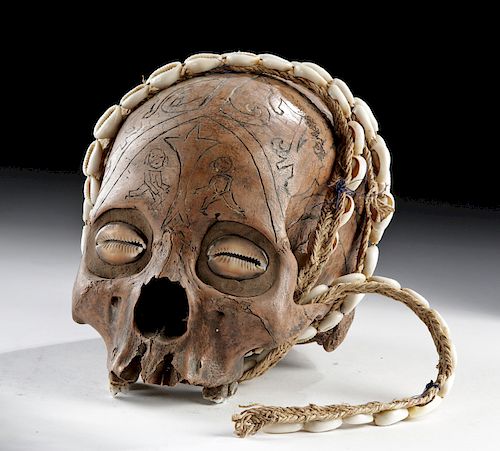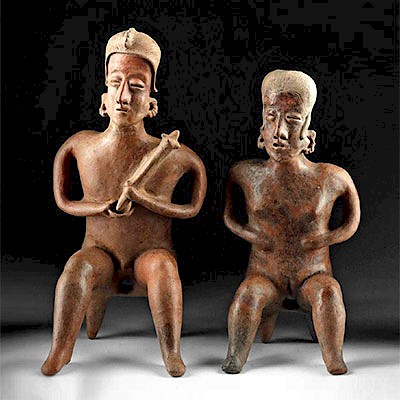Early 20th C. Dayak Human Trophy Skull w/ Cowrie Shells
Lot 167e
About Seller
Artemis Fine Arts
686 S Taylor Ave, Ste 106
Louisville, CO 80027
United States
Selling antiquities, ancient and ethnographic art online since 1993, Artemis Gallery specializes in Classical Antiquities (Egyptian, Greek, Roman, Near Eastern), Asian, Pre-Columbian, African / Tribal / Oceanographic art. Our extensive inventory includes pottery, stone, metal, wood, glass and textil...Read more
Categories
Estimate:
$4,500 - $7,000
Absentee vs Live bid
Two ways to bid:
- Leave a max absentee bid and the platform will bid on your behalf up to your maximum bid during the live auction.
- Bid live during the auction and your bids will be submitted real-time to the auctioneer.
Bid Increments
| Price | Bid Increment |
|---|---|
| $0 | $25 |
| $300 | $50 |
| $1,000 | $100 |
| $2,000 | $250 |
| $5,000 | $500 |
| $10,000 | $1,000 |
| $20,000 | $2,500 |
| $50,000 | $5,000 |
| $100,000 | $10,000 |
| $200,000 | $20,000 |
About Auction
By Artemis Fine Arts
May 23, 2019
Set Reminder
2019-05-23 10:00:00
2019-05-23 10:00:00
America/New_York
Bidsquare
Bidsquare : Exceptional Day 2 Ethnographic Tribal Fossils
https://www.bidsquare.com/auctions/artemis-gallery/exceptional-day-2-ethnographic-tribal-fossils-4136
Day 2 of an important 2-day auction featuring exceptional ethnographic art from around the world. Today's sale will feature Pre-Columbian from the ancient americas, Native American, African / Tribal, Oceanic, Spanish Colonial, and incredible Fossils. Artemis Fine Arts info@artemisfinearts.com
Day 2 of an important 2-day auction featuring exceptional ethnographic art from around the world. Today's sale will feature Pre-Columbian from the ancient americas, Native American, African / Tribal, Oceanic, Spanish Colonial, and incredible Fossils. Artemis Fine Arts info@artemisfinearts.com
- Lot Description
Southeast Asia, Indonesia, Borneo, Central Kalimantan, Dayak peoples, ca. early 20th century CE. A beautiful example of a headhunter's trophy skull, known as an "ndaokus," adorned with intricate linear, zoomorphic, and anthropomorphic motifs. Fine patina has developed along the exterior surfaces. Large cowrie shells cover the eyes and a string of cowrie shells sewn onto a woven grass fiber cord is wrapped through the zygomatic arch on either side. Size: 5.5" W x 6" H (14 cm x 15.2 cm)
The Dayak people of old were feared hunters known for their occasional cannibalistic tendencies as well as their affinity and cultural attachment to headhunting. Young men would symbolically transition into manhood by being tasked with taking the life of an enemy combatant. This practice enabled young warriors to prove their masculinity and bravery by taking possession of the soul of the slain foe. The collected skulls were kept in the house of the hunter as trophies, proof of their prowess as a warrior. Ndaokus skulls generally lack a lower jaw because the mandible was removed and given to the women as necklace pendants for a penultimate insult toward the defeated enemy.
Provenance: private San Francisco, California, USA collection
All items legal to buy/sell under U.S. Statute covering cultural patrimony Code 2600, CHAPTER 14, and are guaranteed to be as described or your money back.
A Certificate of Authenticity will accompany all winning bids.
We ship worldwide and handle all shipping in-house for your convenience.
#146550Rich patina on surface. Most of the teeth are lost and there is no mandible present as some examples have. Some of the teeth present have been reattached.Condition
- Shipping Info
-
All shipping is handled in-house for your convenience. Your invoice from Artemis Gallery will include shipping calculation instructions. If in doubt, please inquire BEFORE bidding for estimated shipping costs for individual items.
-
- Buyer's Premium



 EUR
EUR CAD
CAD AUD
AUD GBP
GBP MXN
MXN HKD
HKD CNY
CNY MYR
MYR SEK
SEK SGD
SGD CHF
CHF THB
THB
















